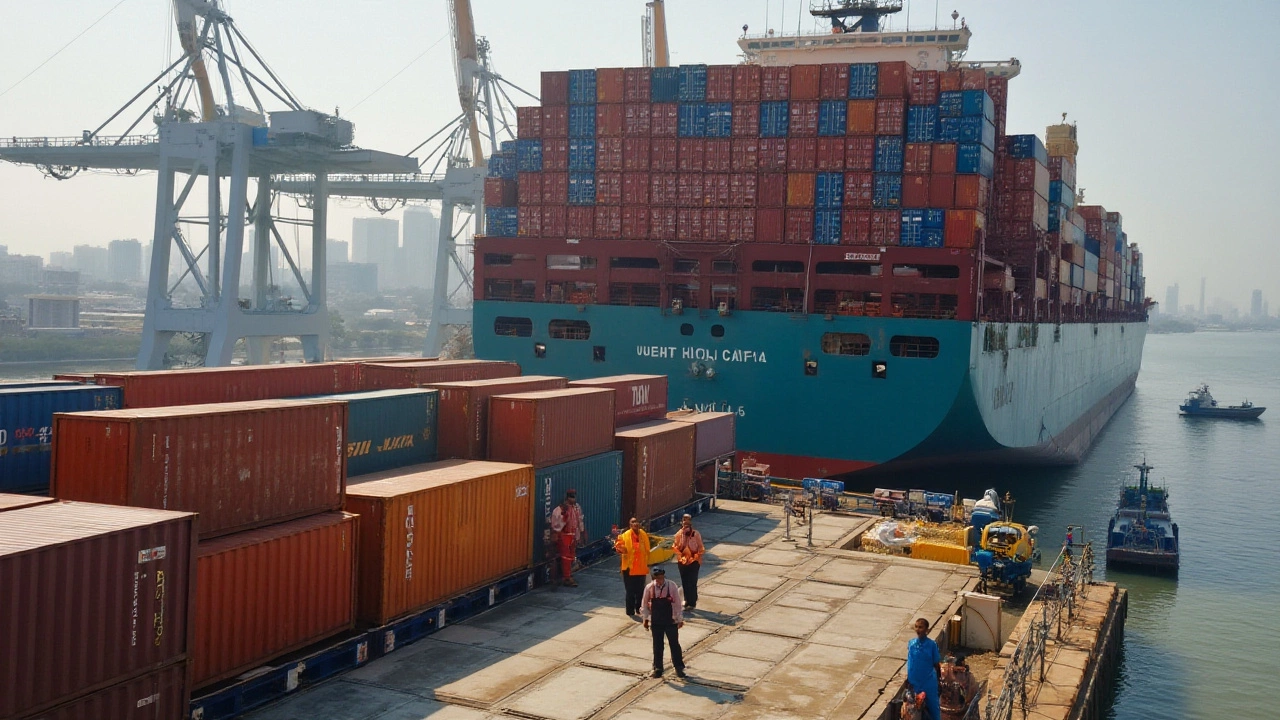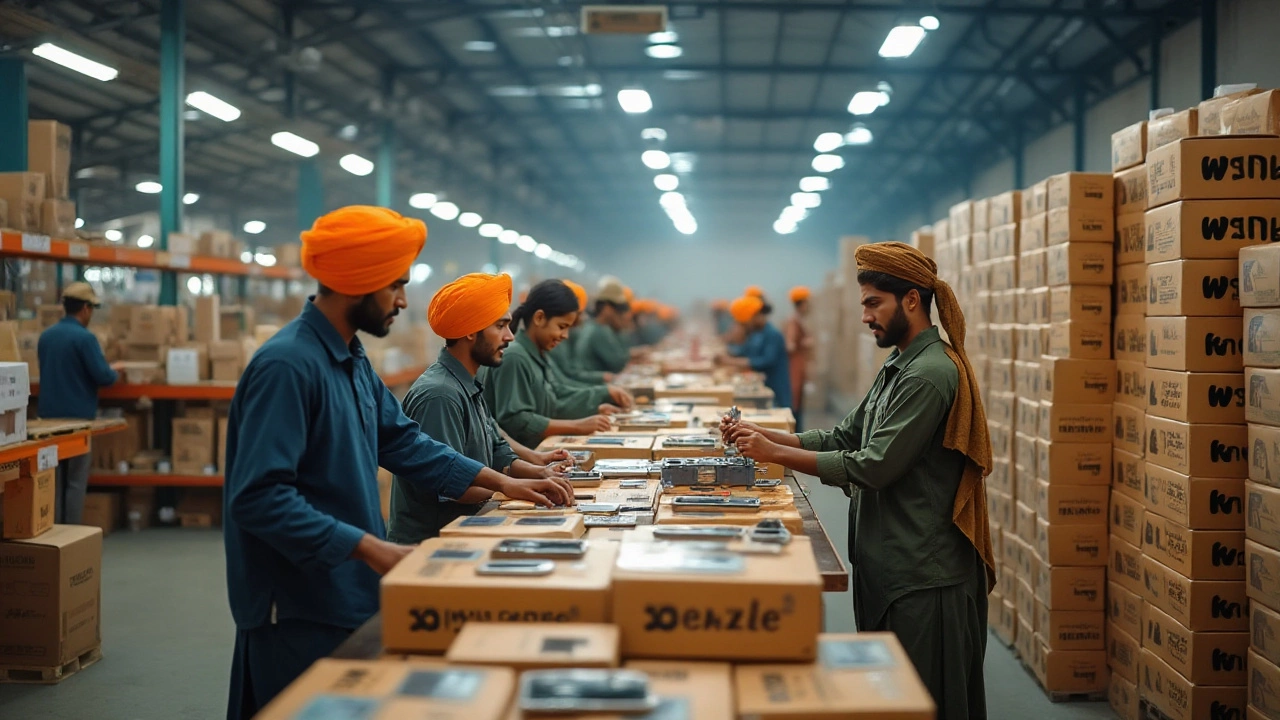Navigating the waters of international shipping, especially for electronics, can be a labyrinth of sealed crates, numbers, and red tape. When shipping a product from India to the USA, manufacturers encounter various expenses that demand careful calculation.
From the bustling factories of India to the meticulously organized unloading docks in America, every step involves distinct costs and considerations. Understanding these can save potential headaches and money in the logistics journey. Dive in with us as we explore the ins and outs of shipping electronics across continents.
- Understanding Shipping Costs
- Types of Shipping Methods
- Packaging and Insurance
- Customs and Duties
- Cost-Saving Tips
Understanding Shipping Costs
The journey of shipping electronics from the vibrant markets of India to the dynamic tech landscape of the USA is as much a test of economic savvy as it is a logistical endeavor. The costs incurred along this route are influenced by a web of factors that range from practical to policy-driven considerations. At the heart of this process are the basic expenses which include the cost of the goods themselves, transportation charges, tariffs, and a myriad of other unforeseen impurities that often sneak their way in. Transport fees undeniably form the backbone of this expenditure, often reflecting the chosen mode of shipping, be it by air or sea, and the urgency of the delivery. Airfreight generally commands higher costs due to its swifter delivery times, appealing to businesses that prize speed above economy, while ocean freight tends to offer a budget-friendly alternative, albeit at the expense of time.
Hidden beneath these apparent costs are subtle yet significant charges such as warehousing fees, fuel surcharges, and fluctuating currency rates which constantly shift the ground beneath one's budget. Each port of entry along the way introduces its own set of logistical dances that sway the costs incrementally skyward. Speaking to this perennial challenge, a logistics manager might say, "Navigating shipping rates is akin to predicting the weather; informed guesses rarely account for every storm." The logistics ecosystem teems with unpredictability, driven by factors like seasonal changes, global economic trends, and even geopolitical tensions that can abruptly swing the pendulum of expense in unexpected directions.
Applying a more in-depth lens, there's the factor of customs duties which vary based on the nature of the electronics being shipped, their purpose, and even their destination within the USA. It's pertinent for manufacturers to stay updated with both Indian and American trade policies, as changes here can vastly alter cost estimates. Certain products might be subject to exemptions under free trade agreements, offering lucrative cost savings if one is sufficiently astute to capitalize on them. In today's highly connected world, the technological element cannot be ignored. Advanced shipping software enables real-time tracking and monitoring, offering stakeholders newfound transparency into potential cost variations and allowing timely interventions to minimize expenses.
Types of Shipping Methods
When it comes to choosing shipping methods for electronics traveling from India to the USA, there are several routes one might consider. Those in the business of logistics might notice terms like air freight, sea freight, express sending, and mail services bouncing around a lot. Each of these options comes with its own set of pros and cons. To begin, air freight is often hailed as the swiftest method, perfect for those on a strict timeline. While the speed is beneficial, it's worth noting that this method might weigh heavier on the budget. Speed often comes with an increased price tag.
Discussing sea freight, this method is all about balance and bulk. For those seeking economical options, it offers the lowest cost per kilogram, especially for larger shipments. Sea freight's biggest selling point is volume; it can handle substantial amounts of goods at a time. The trade-off is, of course, time. Shipments can take weeks to traverse the oceans and reach American shores. For businesses planning with a larger margin for lead times, this could be the ideal choice.
Next in line would be express courier services, which are a bit of both worlds. They promise speed and reliability, shining in situations where the shipment isn't volumetric but time-sensitive all the same. Companies like DHL, FedEx, and UPS dominate this domain and provide the relief of tracking capabilities, which many businesses find invaluable. These services cater wonderfully to small and urgent consignments of electronics. However, the prices typically escalate with the urgency of the package.
A fourth option, often overlooked, is the mail service. Perfect for items under the radar, it fits into a neat middle ground. It's cost-effective for relatively light packages that aren't in a hurry to reach their destinations. This method appeals to small businesses looking to cut corners without skimping on assurance.
According to shipping expert Mark Williams, "Choosing the right shipping method can make or break a company's margins. It's crucial to align the choice with the nature of the product and business timelines."
Given these options, one might pause and consider which method aligns best with their needs. Different methods cater to varied requirements like time, money, and security. No one-size-fits-all here, making the decision a pivotal moment in the logistics planning process.

Packaging and Insurance
Effective packaging serves as the protective shield for electronics during their long journey from India to the USA. It's not just about stuffing a gadget into a box and hoping for the best. The right kind of packaging minimizes damage risks and, by extension, potential financial loss. Robust packaging involves a multi-layered approach, starting with anti-static bags to avoid electrostatic discharge, which is critical for safeguarding electronic components. This layer is followed by using cushioning materials like bubble wrap or foam, absorbing shocks during transit. Finally, the exterior packaging should be sturdy, often involving corrugated boxes that provide structural integrity. But packaging isn’t merely about physical protection—it's crucial to consider the legalities, as each product must often be labeled with detailed specifications, origin details, and shipping barcodes to ensure it clears customs smoothly.
Insurance, on the other hand, offers financial protection should the unfortunate event of loss or damage occur. Given the potentially high value of electronics being shipped, insurance isn't just advisable—it's indispensable. Various types of insurance are available, such as marine insurance for ocean freight and cargo insurance for air shipments. The choice depends on several factors like the mode of transport, value of merchandise, and specific risks associated with the route. As Benjamin Franklin put it, "An ounce of prevention is worth a pound of cure," which holds particularly true when insuring valuable shipments. The premiums paid are a small price compared to the potential losses faced when shipping electronics internationally without coverage.
Here’s a significant tip for both packing and insuring your electronic goods: always consult with professionals who specialize in shipping electronics. Their expertise ensures packaging materials meet international standards and that insurance policies are suitable for your unique needs. Consider collaborating with logistics partners who have dedicated programs for electronics. Some of these providers often offer tailored solutions, such as climate-controlled warehousing or specialized handlers who understand the delicacies of electronic components, reducing risks and optimizing logistical flow.
The choice of insurance can also be influenced by factors such as the shipping method—air freight, often preferred for its speed, usually comes at a premium, while sea freight might offer more affordable insurance options but requires planning for longer transit durations. Manufacturers must also be aware of the Incoterms involved in the transaction, as it determines who bears the cost and responsibility of the shipment during different stages of its journey. Understanding these terms is vital for negotiating better insurance rates. Always ensure your terms are in line with buyer expectations, so there’s clarity on who insures what part of the journey.
Customs and Duties
When shipping electronics from India to the USA, understanding customs and duties is pivotal to ensuring a smooth and cost-effective transport process. Customs duties are essentially taxes imposed on the import and export of goods, functioning as a regulatory measure that protects domestic industries. In the context of electronics manufacturing, these charges can significantly impact the overall cost of shipping. The duty rates vary depending on the type and value of the goods. For instance, high-tech electronics might be subject to different duty rates compared to basic electronic components. It is crucial for businesses to be clear about the Harmonized Tariff Schedule (HTS) codes applicable to their products, as these codes determine the exact customs duties applied at the US border.
The paperwork that accompanies shipments is another critical aspect. Complete and accurate documentation is key to avoiding delays and unexpected charges. This often includes the commercial invoice, packing list, bill of lading, and sometimes additional permits or certificates depending on the product type. Mistakes or omissions in these documents can lead to substantial hold-ups, which in turn can increase costs through storage fees at ports or expedited customs inspections. Time, after all, is money, especially when it comes to logistics. Businesses must therefore ensure that all paperwork is meticulously prepared and compliant with regulatory standards.
One practical tip for businesses is to stay informed about trade agreements between India and the USA, as these agreements can sometimes lower tariffs or offer duty exemptions for certain products. Awareness and application of these agreements can provide significant financial relief. Knowledge of import regulations becomes even more crucial when dealing with cutting-edge technology and sensitive electronics that may be subject to additional scrutiny under specific regulatory standards. Reliability in keeping abreast with regulatory updates helps maintain compliance and smoothens the entire shipping process.
Sometimes businesses prefer to hire customs brokers to handle the nitty-gritty of customs and duties. A customs broker is a licensed professional who knows the ins and outs of international shipping and customs regulations. They can be immensely helpful, especially when you're dealing with complex shipments or if you're new to importing into the USA from India. Employing a broker can save time and prevent costly mistakes by ensuring that duty payments are made on time and paperwork is filed correctly.
"Understanding the landscape of international trade is imperative. It can mean the difference between success and financial drain." - John Doe, International Trade Expert
To provide a clearer picture, here’s a quick look at possible customs duty exemptions for electronics:
| Electronics Category | Potential Duty Rate (approx.) | Trade Agreement Notes |
|---|---|---|
| Mobile Devices | 0% - 10% | Vary based on specific agreements |
| Computers | 0% - 5% | Often falls under Near-Zero Duties in Some Scenarios |
| Electronic Components | 2% - 8% | Subject to Standards |
In conclusion, while the logistics of shipping goods from India to the USA can often seem daunting due to the complex interaction of customs and duties, with the right preparation and knowledge, it is entirely manageable. By emphasizing precise documentation, compliance with trade regulations, and, when possible, leveraging the expertise of customs brokers, businesses can achieve a seamless import process.

Cost-Saving Tips
Slashing costs without sacrificing quality is an art, especially when shipping electronics from bright, bustling India to the vast US market. Of course, the fundamental step towards saving is understanding where and why these costs arise. Packing techniques, shipping modes, timing, and choice of partners can all play roles in trimming the budget. Let's explore the hidden gems of cost-saving that could help businesses ship more efficiently from one continent to another.
One can unlock substantial savings by choosing the right shipping methods. Air freight is fast but often heavy on the wallet, whereas sea freight takes longer but might align better with bulk shipping and tight budgets. If time allows, opting for slower transport methods could lead to sizeable savings. A wise strategy here is to forecast demand accurately, thus planning the shipments well in advance. This approach not only reduces costs but also ensures a steady flow of inventory. Creating a balance between air and sea freight, combined with volume discounts that many carriers offer for larger shipments, can be a powerful tactic for reducing shipping costs.
Next up is the essential task of optimizing packaging. Electronics, often being fragile or containing sensitive components, require special care. Efficient packaging not only protects these goods but can also drastically reduce costs. By using lightweight and durable materials like polybags or custom-sized boxes, you reduce both weight and volume, cutting down on shipping charges. Plus, some companies might offer incentives for sustainable, eco-friendly packaging solutions. The key is finding that sweet spot between ensuring protection and avoiding excess expense.
Another notable strategy is negotiating better rates with logistics partners. For businesses which anticipate regular shipments, market clout can be enhanced by signing contracts for a longer duration. Many shipping carriers offer reduced fees for clients that provide them with regular, steady work. As a business, showing loyalty and a commitment to one carrier might just give you leverage when it’s time to talk discounts.
Keeping abreast of geopolitical landscapes and international trade policies can also lead to savings. By anticipating policy changes or tariffs, businesses can adapt their strategies accordingly. As the famous logistics expert Marcus Wagner once advised,
"The smartest companies are the ones who look at trade policies as opportunities rather than obstacles."Understanding the regulatory environment could guide businesses to ship during low-tariff periods or use free trade agreements to their advantage.
Lastly, consider maintaining an in-depth understanding of Customs and Duties regulations. Preempting potential hiccups can save significant amounts in fees and fines. Training internal teams or hiring consultants with expertise in international trade regulations can lead to smoother transitions and significant cost reductions. Remember, knowing the rules is half the battle won.
Implementing a strategy that includes each aforementioned tip can deeply reduce associated costs when shipping electronics from India to the USA. While every business has its unique logistical needs, these proven steps offer a solid foundation for smarter, more cost-effective international shipping.
